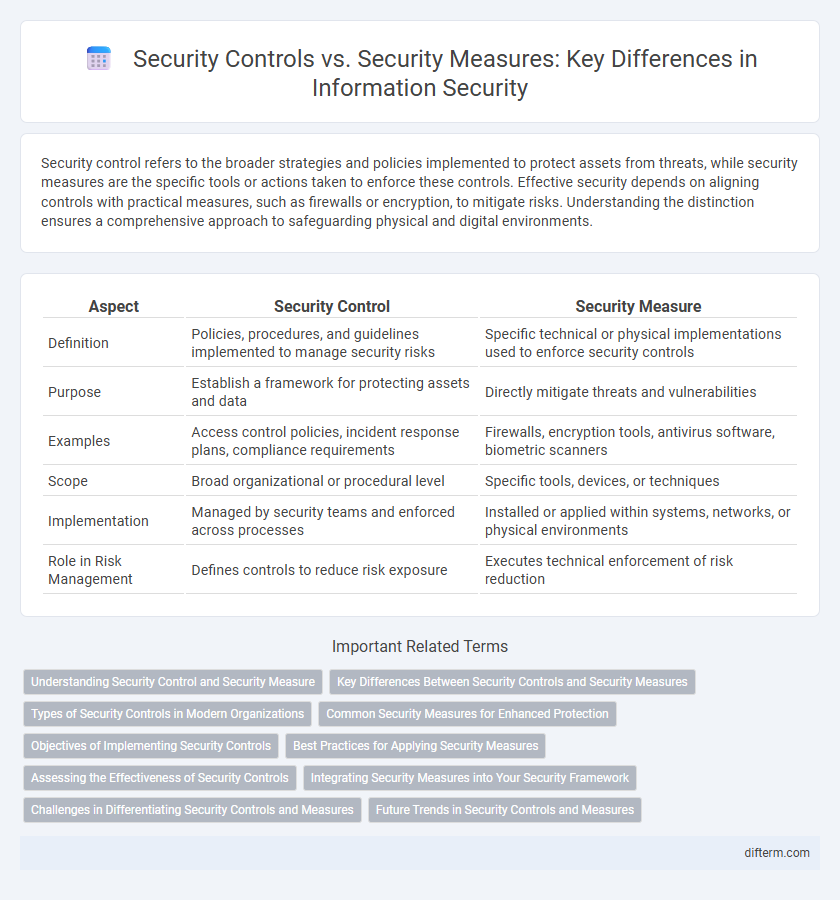Security control refers to the broader strategies and policies implemented to protect assets from threats, while security measures are the specific tools or actions taken to enforce these controls. Effective security depends on aligning controls with practical measures, such as firewalls or encryption, to mitigate risks. Understanding the distinction ensures a comprehensive approach to safeguarding physical and digital environments.
Table of Comparison
| Aspect | Security Control | Security Measure |
|---|---|---|
| Definition | Policies, procedures, and guidelines implemented to manage security risks | Specific technical or physical implementations used to enforce security controls |
| Purpose | Establish a framework for protecting assets and data | Directly mitigate threats and vulnerabilities |
| Examples | Access control policies, incident response plans, compliance requirements | Firewalls, encryption tools, antivirus software, biometric scanners |
| Scope | Broad organizational or procedural level | Specific tools, devices, or techniques |
| Implementation | Managed by security teams and enforced across processes | Installed or applied within systems, networks, or physical environments |
| Role in Risk Management | Defines controls to reduce risk exposure | Executes technical enforcement of risk reduction |
Understanding Security Control and Security Measure
Security control refers to a safeguard or countermeasure implemented to protect information assets and reduce risks, encompassing technical, administrative, and physical elements. Security measures are specific actions or procedures taken to enforce security controls, such as encryption protocols, access restrictions, or intrusion detection systems. Understanding the distinction highlights that controls are overarching frameworks while measures are the practical implementations ensuring compliance and effectiveness.
Key Differences Between Security Controls and Security Measures
Security controls are the management, technical, or operational actions implemented to reduce risks and protect assets, whereas security measures are specific methods or tools applied within those controls to enforce security policies. Key differences include controls being broader frameworks or policies like access control policies, while measures involve tangible practices such as encryption or firewalls. Security controls provide the strategic direction and governance, whereas security measures represent practical implementations ensuring compliance and protection.
Types of Security Controls in Modern Organizations
Physical, technical, and administrative controls represent the primary types of security controls implemented in modern organizations to safeguard assets and information. Physical controls include barriers such as locks and security guards, technical controls encompass firewalls, encryption, and intrusion detection systems, while administrative controls involve policies, procedures, and training designed to manage risk. These security controls collectively create a layered defense strategy that addresses vulnerabilities across different organizational domains.
Common Security Measures for Enhanced Protection
Common security measures such as firewalls, encryption, multi-factor authentication, and regular software updates play a critical role in enhancing protection by mitigating vulnerabilities and preventing unauthorized access. Security controls encompass these measures as specific mechanisms or procedures implemented to enforce security policies and reduce risks. Implementing layered security measures ensures a robust defense against cyber threats and data breaches in complex IT environments.
Objectives of Implementing Security Controls
Security controls are implemented to protect information assets by preventing, detecting, and responding to security threats. Their primary objectives include ensuring confidentiality, integrity, and availability of data while managing risks and compliance requirements. Effective security measures reduce vulnerabilities and enhance organizational resilience against cyber attacks and data breaches.
Best Practices for Applying Security Measures
Effective security measures are essential components within a broader security control framework designed to protect information assets from threats and vulnerabilities. Best practices for applying security measures emphasize regular risk assessments, layering defenses through multiple control types, and continuous monitoring to detect and respond to incidents swiftly. Implementing adaptive security measures alongside organizational policies ensures resilient protection tailored to evolving threat landscapes.
Assessing the Effectiveness of Security Controls
Assessing the effectiveness of security controls involves systematically evaluating their ability to prevent, detect, and respond to threats within an organization's risk environment. Security controls are established safeguards or countermeasures such as firewalls, access controls, and encryption protocols, while security measures refer to specific actions or tools implemented to enforce these controls. Continuous monitoring, vulnerability assessments, and penetration testing provide critical data to measure control performance against security objectives and compliance requirements.
Integrating Security Measures into Your Security Framework
Integrating security measures into your security framework enhances the effectiveness of existing security controls by addressing specific vulnerabilities and operational risks. Security controls establish the overarching policies and procedures, while security measures implement targeted actions such as encryption, access restrictions, and multi-factor authentication to enforce these controls. A cohesive integration ensures continuous monitoring and adaptive responses, strengthening overall defense mechanisms against cyber threats.
Challenges in Differentiating Security Controls and Measures
Distinguishing between security controls and security measures presents challenges due to overlapping definitions and implementation scopes within cybersecurity frameworks. Security controls encompass broad categories such as administrative, technical, and physical barriers, while security measures often refer to specific actions or tools applied to enforce those controls. The ambiguity in terminology leads to inconsistent application and documentation, complicating compliance auditing and risk management efforts in organizational security strategies.
Future Trends in Security Controls and Measures
Emerging trends in security controls emphasize the integration of artificial intelligence and machine learning to proactively detect and mitigate threats with greater accuracy. Zero trust architecture continues gaining traction, shifting security measures from perimeter-based models to continuous verification of user identity and device health. Cloud-native controls and automation enhance scalability and responsiveness, enabling organizations to adapt rapidly to evolving cyber risks.
Security Control vs Security Measure Infographic

 difterm.com
difterm.com